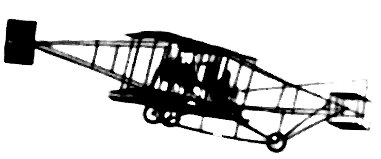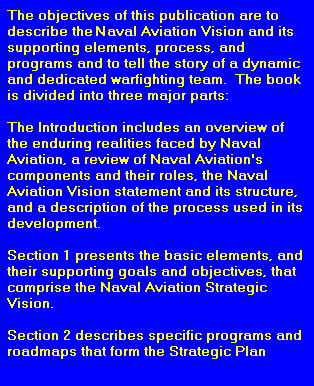 When Eugene
Ely flew his Curtiss biplane from a wooden platform mounted above the bow
of USS Birmingham in November 1910, and when 1st Lieutenant Alfred A. Cunningham,
Marine Aviator Number One, climbed into the cockpit of his leaking Wright
hydroplane two years later, no one could imagine that in another 87 years
Naval Aviation would stand at the dawn of a new century with power and
expeditionary capabilities unmatched by any other force.
When Eugene
Ely flew his Curtiss biplane from a wooden platform mounted above the bow
of USS Birmingham in November 1910, and when 1st Lieutenant Alfred A. Cunningham,
Marine Aviator Number One, climbed into the cockpit of his leaking Wright
hydroplane two years later, no one could imagine that in another 87 years
Naval Aviation would stand at the dawn of a new century with power and
expeditionary capabilities unmatched by any other force.
 The first decades
of the 20th century were times of significant change and innovation for
the Navy and Marine Corps, as aviation began to make its presence felt
in naval and expeditionary operations. The first decades of the 21st century
will continue to see change and innovation brought on by an evolving strategic
environment, new operational concepts, and advances in aircraft, weapons,
and information technologies. Naval Aviation is adapting to new circumstances,
even in this period of constrained defense spending. This is an imperative
that cannot be avoided, because the importance of naval power to U.S. strategy
and the importance of Naval Aviation to U.S. naval operations are as great
as ever. In a world in which the United States has vital interests overseas,
Navy and Marine Corps forces provide key forward-presence, crisis-response,
and warfighting capabilities to our nation's leaders and joint commanders.
Naval Aviation plays a central role in every naval mission, from establishing
battlespace dominance to projecting power ashore.
The first decades
of the 20th century were times of significant change and innovation for
the Navy and Marine Corps, as aviation began to make its presence felt
in naval and expeditionary operations. The first decades of the 21st century
will continue to see change and innovation brought on by an evolving strategic
environment, new operational concepts, and advances in aircraft, weapons,
and information technologies. Naval Aviation is adapting to new circumstances,
even in this period of constrained defense spending. This is an imperative
that cannot be avoided, because the importance of naval power to U.S. strategy
and the importance of Naval Aviation to U.S. naval operations are as great
as ever. In a world in which the United States has vital interests overseas,
Navy and Marine Corps forces provide key forward-presence, crisis-response,
and warfighting capabilities to our nation's leaders and joint commanders.
Naval Aviation plays a central role in every naval mission, from establishing
battlespace dominance to projecting power ashore.
As Naval Aviation modernizes itself for operations in the next century,
it requires an integrated roadmap that charts where it is  going
and how it intends to get there. Created with continuous inputs from all
the communities that comprise Naval Aviation, this Strategic Vision and
Plan will serve as that roadmap. It is a "living" document that will be
updated and adjusted over time to reflect operational, technological, and
programmatic changes. It will also continue to be a focal point around
which Naval Aviation develops a consensus on its future direction.
going
and how it intends to get there. Created with continuous inputs from all
the communities that comprise Naval Aviation, this Strategic Vision and
Plan will serve as that roadmap. It is a "living" document that will be
updated and adjusted over time to reflect operational, technological, and
programmatic changes. It will also continue to be a focal point around
which Naval Aviation develops a consensus on its future direction.
 Naval Aviation Vision Statement
Naval Aviation Vision Statement  Chief of Naval Operations Foreword
Chief of Naval Operations Foreword  Commandant of the Marine Corps Foreword
Commandant of the Marine Corps Foreword
 Introduction
Introduction  New Challenges...Enduring Realities
New Challenges...Enduring Realities  Naval Aviation:
Capabilities for Today... and Tomorrow
Naval Aviation:
Capabilities for Today... and Tomorrow
 Sharpening
the Vision: The Process
Sharpening
the Vision: The Process  Section 1: Element Definitions and Goals
Section 1: Element Definitions and Goals
 Section
2: Program Plans, Descriptions and Roadmaps
Section
2: Program Plans, Descriptions and Roadmaps  Acronyms
Acronyms  Director Air Warfare Closing Remarks
Director Air Warfare Closing Remarks
 When Eugene
Ely flew his Curtiss biplane from a wooden platform mounted above the bow
of USS Birmingham in November 1910, and when 1st Lieutenant Alfred A. Cunningham,
Marine Aviator Number One, climbed into the cockpit of his leaking Wright
hydroplane two years later, no one could imagine that in another 87 years
Naval Aviation would stand at the dawn of a new century with power and
expeditionary capabilities unmatched by any other force.
When Eugene
Ely flew his Curtiss biplane from a wooden platform mounted above the bow
of USS Birmingham in November 1910, and when 1st Lieutenant Alfred A. Cunningham,
Marine Aviator Number One, climbed into the cockpit of his leaking Wright
hydroplane two years later, no one could imagine that in another 87 years
Naval Aviation would stand at the dawn of a new century with power and
expeditionary capabilities unmatched by any other force. The first decades
of the 20th century were times of significant change and innovation for
the Navy and Marine Corps, as aviation began to make its presence felt
in naval and expeditionary operations. The first decades of the 21st century
will continue to see change and innovation brought on by an evolving strategic
environment, new operational concepts, and advances in aircraft, weapons,
and information technologies. Naval Aviation is adapting to new circumstances,
even in this period of constrained defense spending. This is an imperative
that cannot be avoided, because the importance of naval power to U.S. strategy
and the importance of Naval Aviation to U.S. naval operations are as great
as ever. In a world in which the United States has vital interests overseas,
Navy and Marine Corps forces provide key forward-presence, crisis-response,
and warfighting capabilities to our nation's leaders and joint commanders.
Naval Aviation plays a central role in every naval mission, from establishing
battlespace dominance to projecting power ashore.
The first decades
of the 20th century were times of significant change and innovation for
the Navy and Marine Corps, as aviation began to make its presence felt
in naval and expeditionary operations. The first decades of the 21st century
will continue to see change and innovation brought on by an evolving strategic
environment, new operational concepts, and advances in aircraft, weapons,
and information technologies. Naval Aviation is adapting to new circumstances,
even in this period of constrained defense spending. This is an imperative
that cannot be avoided, because the importance of naval power to U.S. strategy
and the importance of Naval Aviation to U.S. naval operations are as great
as ever. In a world in which the United States has vital interests overseas,
Navy and Marine Corps forces provide key forward-presence, crisis-response,
and warfighting capabilities to our nation's leaders and joint commanders.
Naval Aviation plays a central role in every naval mission, from establishing
battlespace dominance to projecting power ashore. going
and how it intends to get there. Created with continuous inputs from all
the communities that comprise Naval Aviation, this Strategic Vision and
Plan will serve as that roadmap. It is a "living" document that will be
updated and adjusted over time to reflect operational, technological, and
programmatic changes. It will also continue to be a focal point around
which Naval Aviation develops a consensus on its future direction.
going
and how it intends to get there. Created with continuous inputs from all
the communities that comprise Naval Aviation, this Strategic Vision and
Plan will serve as that roadmap. It is a "living" document that will be
updated and adjusted over time to reflect operational, technological, and
programmatic changes. It will also continue to be a focal point around
which Naval Aviation develops a consensus on its future direction.